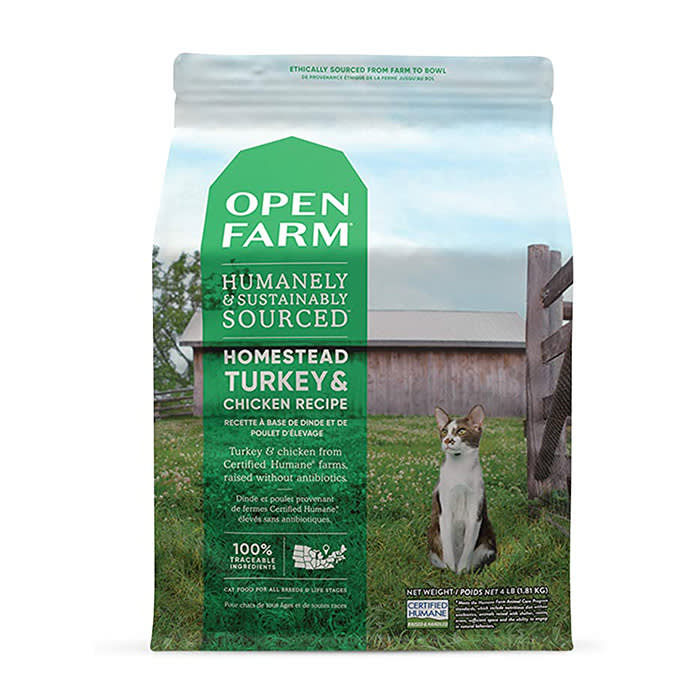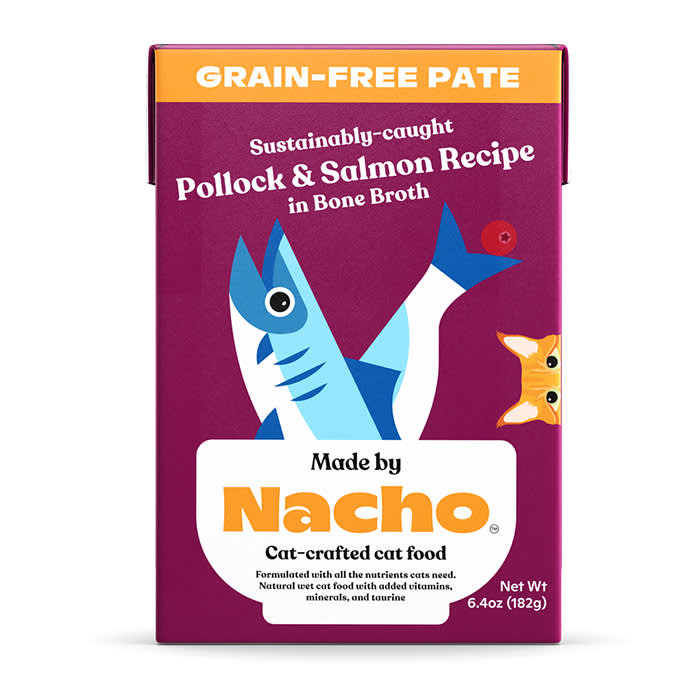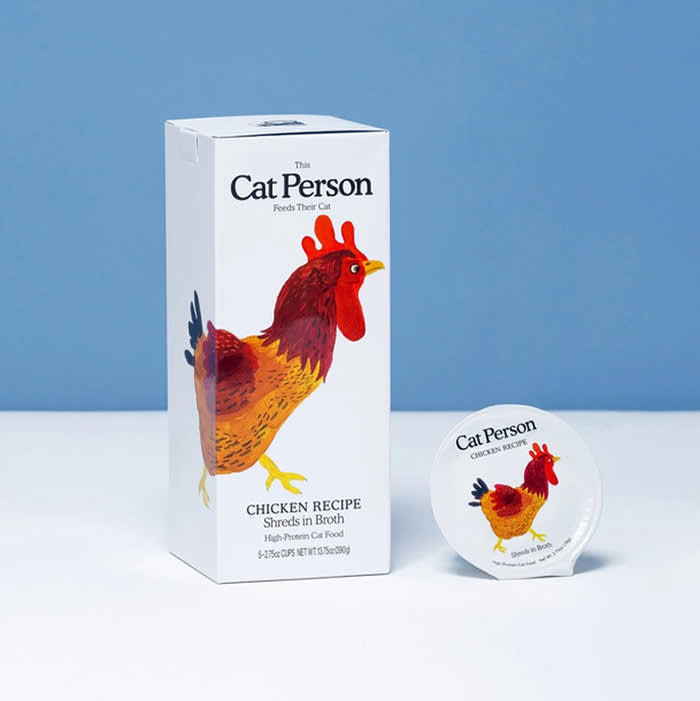Does Your Cat Really Need to Go Grain-Free?
You’ve got questions. Dr. Bruce Kornreich, director of the Cornell Feline Health Center, has answers.

Share Article
When I started to write about grain-free cat food, I didn’t have a clue as to whether a grain-free diet was actually good for cats. I might have had a very vague notion that grain-free food contained more meat, and therefore had more of what my cat wanted to eat. But I wasn’t confident in that assessment, either.
It wasn’t long after I began working on this story that I realized the food my cat eats is, in fact, grain-free. Go figure. The next time I paid a visit to my local bougie pet boutique, I couldn’t find a single food product for cats (or dogs, for that matter) that wasn’t labeled as grain-free. Strange. Next, I went to a big-box pet store to see if I could find cat food with grains in the ingredient list, and here, too, I struggled to locate more than a few items that were not billed as being grain-free.
It seemed like everywhere I turned, brands were touting their grain-free pet foods. Was it a conspiracy? There had to be a point to all this, right? Some actual nutritional reason for the great removal of grain from every cat’s diet? I reached out to the director of the Cornell Feline Health Centeropens in new tab, Dr. Bruce Kornreich, to get some answers.
What is it about grain-free diets that makes for controversy?
While grain-free advocates and contrarians may disagree on the cut-and-dry notion of grain versus no grain, they can often find middle ground on the topic of harmful ingredients as it pertains to their beloved pets. The additives used to replace grain, namely, legumes, in some brands that produce grain-free food can cause short-term and long-term sickness in pets, including heart issues.

Although grain-free has come to be seen as a designer diet, the impetus for feeding your pet specialized food is always situational and not all grain-free foods use the additives that can lead to these health problems. If pet parents are searching for grain-free diets that don’t use high-carb fillers, they should explore human-grade food options, such as Raised Right petsopens in new tab.
What kind of food should a cat be eating?
In general, when shopping for cat food, Dr. Kornreich advises that you look for several things, such as ensuring you’re buying food for the right life stage (either kitten or adult). Veterinarian and medical writer Dr. Amy Fox recommends looking for a statement on the product’s label that says it meets the American Association of Feed Control Officials (AAFCO) guidelinesopens in new tab for a nutritionally complete and balanced diet.
The most important thing is to check in with your veterinarian if you’re switching foods or have other concerns related to your cat’s diet. Changing a cat’s diet could have adverse effects on the gastrointestinal system, so Dr. Fox says it’s best to slowly introduce a new food over several weeks.
Should a cat be eating a grain-free diet?
While cats do sometimes develop allergies to foods, they’re more likely to be allergic to proteins rather than carbohydrates. Dr. Kornreich says, “The incidence of a true sensitivity to grain is very low, both in people and in animals.” A sensitivity to food can be identified through an allergy panel and/or an elimination diet with the help of your vet.
Very effective marketingopens in new tab, combined with whatever people have come to believe about the presence of grains in human diets, is ultimately what influences many people’s decisions to buy grain-free food for their dog or cat, while others are simply searching for the healthiest option for their pet.
What’s the problem with grain-free food?
There have been cases of adverse effects in pets that are given grain-free diets. They can develop a heart condition called dilated cardiomyopathy that has been, at times, fatal. According to Dr. Fox, “In cats, dilated cardiomyopathy was historically associated with diets low in taurine, and this is another possible cause that is still under investigation with grain-free diet.” Although the occurrence is most often in dogs and more research needs to be done on the exact causes (the FDA is conducting an investigationopens in new tab), it is possible that high concentrations of pulses, peas, and other legumes in grain-free foods are to blame.
What if the food you’re currently giving your cat is grain-free — should you be concerned?
Maybe? But maybe not? It’s unclear for now. “There are certainly grain-free diets that have the AAFCO label on them, and many, if not most of them, may turn out to be fine,” Dr. Kornreich says, “but until more research is completed, this recommendation is made out of an abundance of caution.” As always, consult with your veterinarian if you have specific questions pertaining to your cat’s nutritional health.
Disclaimer alert: This article is here to share information. But, much like pineapple on pizza, the topic may be controversial. Meaning, not all vets or pet professionals agree. Because every pet is a unique weirdo with specific needs. So, don’t take this as fact or medical advice. Talk things over with your vet when making decisions, and use your best judgment (about both your pet’s health and pizza toppings).
Best Grain-Free Cat Food Options
Btw, our editors (and their pets) picked out these products. They’re always in stock at the time we publish, but there’s a chance they’ll sell out. If you do buy through our links, we may earn a commission. (We’ve got a lot of toys to buy over here, you know?)

Helin Jung
Helin Jung is a writer in Los Angeles.
Related articles
![Cat eating out of a red bowl]()
Does Your Diabetic Cat Need a Special Diet?
Get ready for a sigh of relief — this food doesn’t have to be pricey.
![Dave Coast sitting with a dog]()
Nutritionist Dave Coast Digs Into Grain-Free Dog Food and Heart Disease
The LA wellness guru talks to a holistic veterinarian about the best diet for dogs with allergies and why grain-free food gets a bad rap.
![Hand holding food bowl peeks into frame as a cat looks up expectantly]()
The Ultimate Puzzle: Picking the Right Cat Food
Four veterinary nutritionists pick apart the claims so that you can choose the right food for your kitty.
![Famous Chef, Bobby Flay posing for a picture in a kitchen with his orange cat.]()
Bobby Flay’s New Boss Is a Furry Orange Cat With a Discerning Palate
Inspired — and helmed — by his own Maine Coon, chef Bobby Flay’s Made by Nacho is a pet food brand that puts felines first.
![two people preparing food for their dogs]()
Are Celebrity Chefs Feeding Their Pets Five-Star Meals?
These expert-approved recipes will help you use all the food in your kitchen.
![A woman walking in a golden field during sunset with her dog.]()
Unraveling the Grain-Free Dog Food Debate: Examining the Potential Link to Canine Heart Disease
Integrative veterinarian Dr. Lindsey Wendt shares advice on a sometimes controversial, always changing topic.

















